Hansaton Akustik WL500 Remote control for hearing instruments User Manual
Hansaton Akustik GmbH Remote control for hearing instruments
User Manual
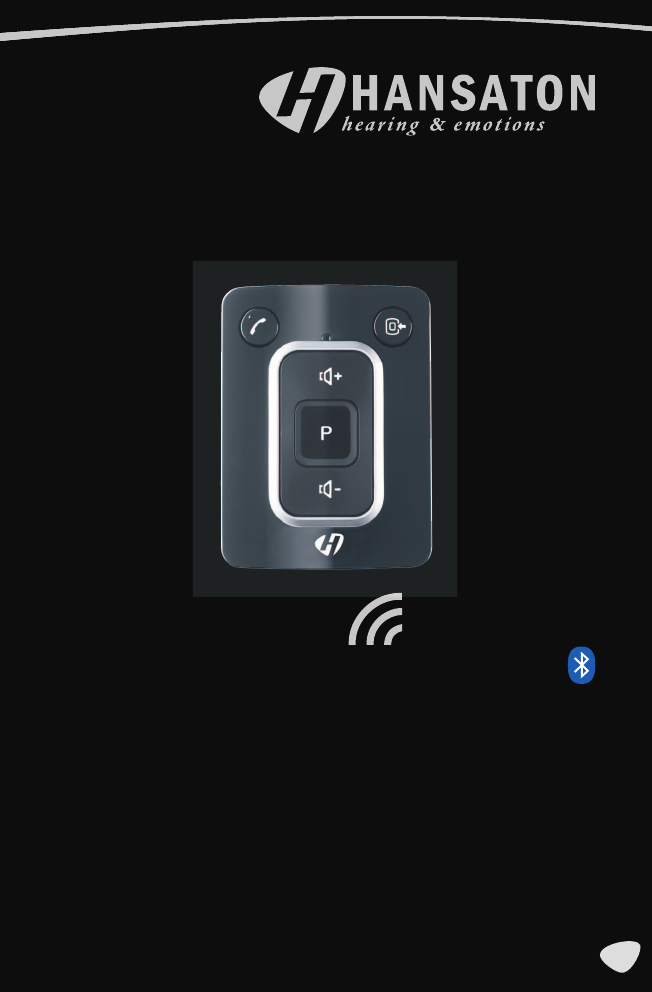
3
Media
mini
Instructions for Use

4
You Have Chosen a Hearing System
from HANSATON
We take pleasure in your choice and congratulate you on your decision,
because with a HANSATON hearing system, you own a high-quality
product of the most modern technology.
For more than 50 years, we have been helping people with our devices to
achieve better hearing and better speech understanding, thus a higher
quality of life.
Your hearing systems equipped with i-com2 technology can be controlled
by your new miniMedia remote control. This remote control offers you
more hearing comfort in your everyday life situations.
Using Bluetooth, it links your hearing systems to the expanding world of
electronic media. It will support you when you watch television, listen to
music, or talk on the phone. In this operating manual, you will find useful
tips on fitting, use and maintenance. If you have further questions, please
contact your hearing system professional.
miniMedia Page 05
Intended Use Page 07
General Notes on Safety Page 08
Safety Notes for Batteries Page 10
Basic Functions Page 11
Bluetooth Page 16
Using miniMedia with Cell Phones and Landline Phones Page 17
Using the Transmitter Page 19
Using the Direct Audio Input Page 22
Using miniMedia with a Third Party Bluetooth Transmitter Page 23
Using miniMedia with a Public Loop System Page 24
Accessories/Using the FM Input Page 24
Maintenance and Care Page 25
Technical Information Page 25
Disposal Information Page 26
FDA Information Page 27
Content
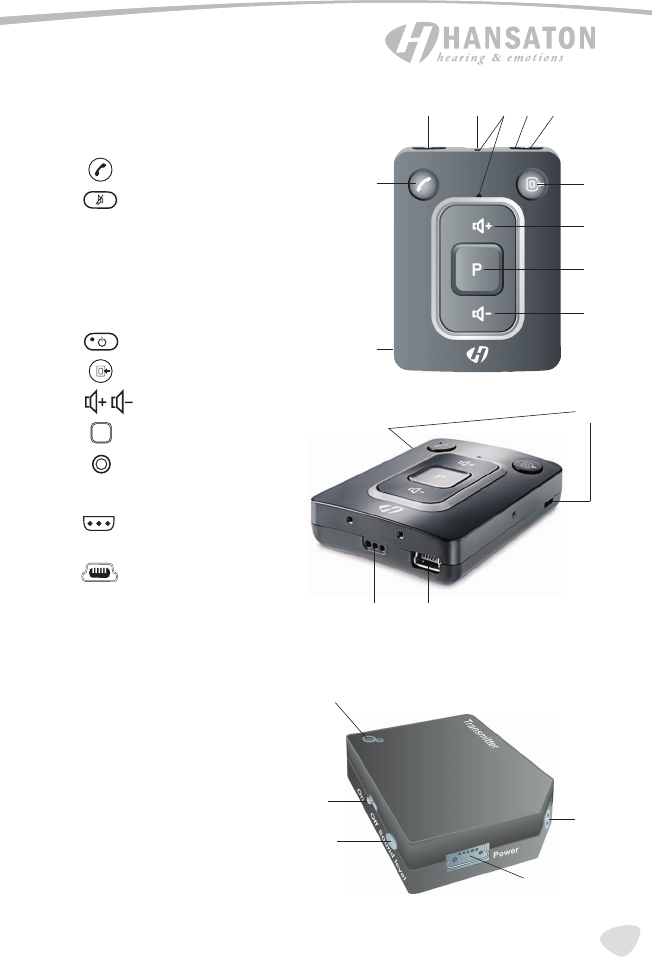
5
1 Telephone button
2 Stand-by for hearing systems;
mute
3 Lanyard attachment
4 Microphone openings
5 Power-LED
6 miniMedia On/Off
7 Audio source button
8 Volume up/Volume down
9 Program change button
10 2,5 mm stereo socket
11 Slots for fixing the clip
12 DAI port for FM receiver
(Direct Audio Input)
13 Socket for power plug
miniMedia with Lanyard and Clip
Transmitter
14 On/Off switch
15 Sound level
16 Socket for
power plug/charging cable
17 2,5 mm stereo socket
18 LED
miniMedia Delivery
1
62 5
7
8
9
8
43
10
12 13
11
P
18
14
15
17
16
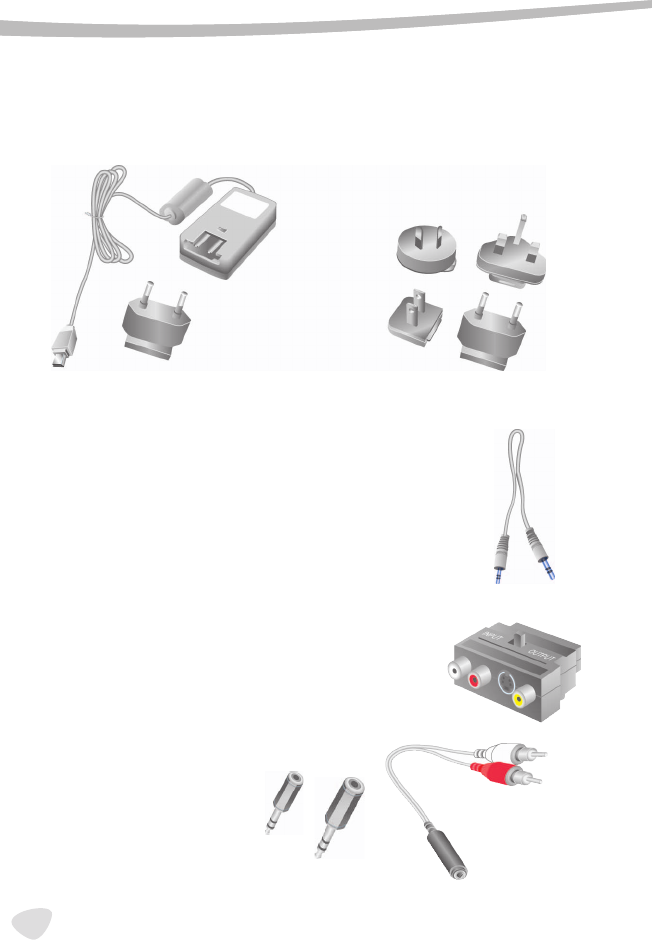
6
2 Power Plugs with Country Specific Adapters
(one for remote control, one for Transmitter)
Cables
• 1.8 m audio cable with 3.5 mm stereo plug on one side
and a 2.5 mm stereo plug on the other side
• 0.3 m audio cable with 3.5 mm stereo plug on one side
and a 2.5 mm stereo plug on the other side
Adapter
• 2.5 mm stereo plug to 3.5 mm stereo socket
• 6.3 mm stereo plug to 3.5 mm stereo socket
• RCA (cinch) to 3.5 mm stereo socket
• RCA (cinch) to SCART
Optional: Traveller set
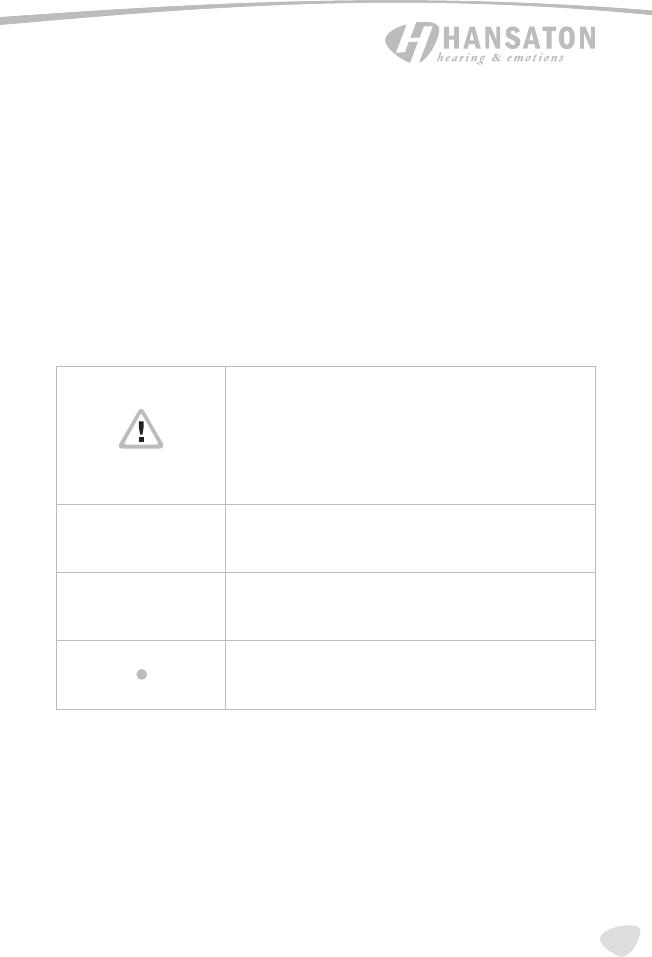
7
Intended Use
This remote control is intended to operate hearing systems.
Read and follow the instructions of this user guide to avoid injuries or
damage to remote control.
WARNING! indicates a situation which can
result in serious injuries.
CAUTION! indicates a situation which can result
in minor to moderate injuries.
NOTICE indicates possible property damage.
Advice and tips on how to handle your hearing
system better.
NOTICE
i
Instruction. Indicates that there is something
you must do.
Symbols
Be aware of information marked with the warning symbol
WARNING!, CAUTION!, or NOTICE!

8
General Notes on Safety
WARNING!
Wireless systems may interfere with measuring devices and electronic
equipment.
• Turn the remote control off when in hospitals or airplanes.
• Prior to use in conjunction with an electronic implant or life supporting
system, have the electromagnetic compatibility verified.
WARNING!
Risk of interference with cardiac pacemakers.
• Do not use the remote control if you are fitted with a cardiac pace-
maker.
WARNING!
Strangulation hazard when lanyard gets entangled in e.g. moving
mechanical parts of machines.
• Use only the delivered breakaway lanyard. It will automatically detach
when entangled.
NOTICE
The remote control is sensitive to extreme heat, high humidity, strong
magnetic fields (> 0.1T), X-rays and mechanical stress.
• Do not expose the remote control to extreme temperature or high
humidity.
• Do not leave it in direct sunlight.
• Do not immerse it in water.
• Do not place your remote control in a microwave oven.
i The performance of the i-com2 function may be affected by electro-
magnetic interference – e.g. from a computer monitor or
fluorescent lamp system.
• Move away from the source of interference if you experience difficulty.

9
i In the event your hearing sytems can be controlled by another person‘s
remote control, return hearing systems and remote control
to your hearing system professional.
i In some countries restrictions for the usage of wireless equipment
exist.
• Refer to local authorities for further information.
WARNING!
Risk in explosive environments (e.g., mining areas)!
• Do not use your hearing systems (and remote control) in areas where
there is a danger of explosions.
NOTICE
Only use the original power adapter supplied
(model no. KSAA0500080W1UV-1;
input: 100-240 V ~, 50-60 Hz, 180 mA
output: 5 V, 800 mA, protection class II,
only for indoor use).
Operating temperature: charge min. 0°C to max. 45°C;
discharge min. -20°C to max. 60°C
NOTICE
Please make sure that the power plug is easily
accessible to remove it from power supply if necessary.
WARNING!
Choking hazard posed by small parts.
• Keep batteries, small parts, and remote control out of children‘s
reach.
• If swallowed, immediately consult a physician or hospital.

10
Safety Notes for Batteries
WARNING!
Risk of explosion when the rechargeable battery is handled wrong.
• Do not remove the battery from the remote control.
• Do not short circuit, pierce, crush, or disassemble the rechargeable bat-
tery.
• Do not place in oven or fire.
• Do not immerse in water.
i Do not dispose of batteries/rechargeable batteries in household trash.
Return them to your hearing system professional for environmentally cor-
rect disposal.

11
Accu full Accu nearly empty
miniMedia off off off
miniMedia on flashes green flashes red
miniMedia off/ green constantly red constantly
charging
miniMedia on/ pulses green pulses red
charging
Turning off green/turns off red/turns off
miniMedia slowly slowly
Turning on green for 3 seconds, red for 3 seconds
miniMedia then flashes green then flashes red
If the miniMedia is switched on when the accu is almost flat, the LED
flashes red for 3 seconds and the remote control switches off again.
Basic Functions
Before First Use
• Charge miniMedia before first use.
Charging
• Connect miniMedia with the power plug to a power supply.
• Charging is complete when the power LED shines green.
Power LED State
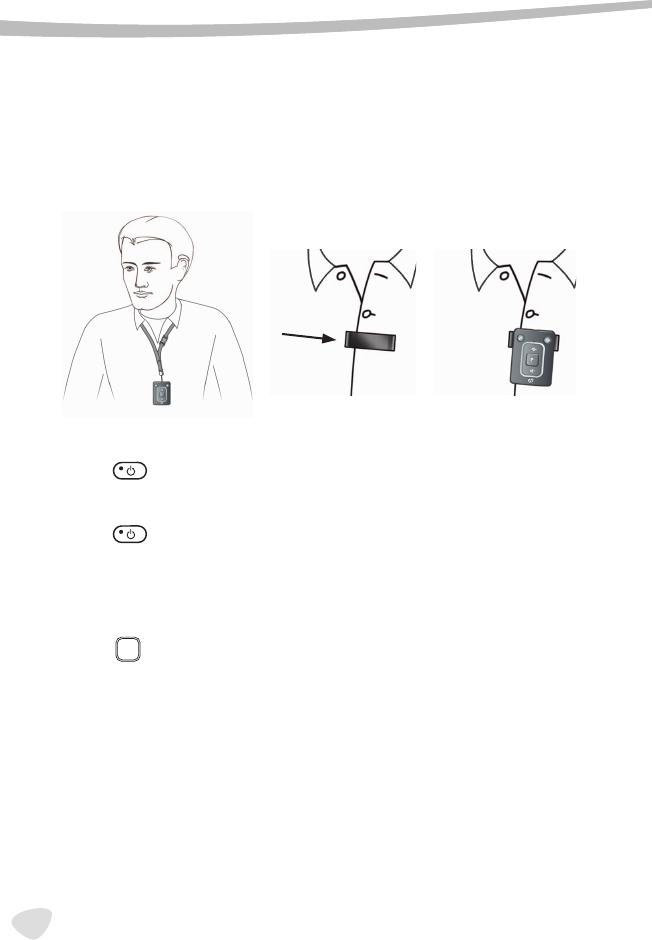
12
Wearing miniMedia
• Wear miniMedia no further than 60 cm (24 inches) away from the hearing
systems.
• Use lanyard or clip to wear miniMedia.
Turning miniMedia On/Off
• Press for about 3 seconds to turn miniMedia on. All LEDs (tele-
phone button, audio source button, On/Off) shine for 3 seconds, then
only the power LED shines.
• Press for about 3 seconds to turn miniMedia off. All LEDs (tele-
phone button, audio source button, On/Off) shine for 3 seconds, then
turn off slowly.
Changing the Hearing Program
• Press P, to change the hearing program.
Each time you press the program button, your hearing systems switch
to the next program, confirming each change with an acoustic signal.
Manually-accessible programs are programmed in by a hearing system
professional.
1 2

13
Changing the Volume
• Press + , to increase the volume.
• Press – , to decrease the volume.
Turning the hearing systems On/Off
• Press for about 3 seconds to turn your hearing systems off (stand-
by).
• Press for about 3 seconds to turn the hearing systems back on.
i Your hearing system professional can activate or deactivate audible
signals in your hearing systems. Audible signals confirm changes in the
settings, such as program, or volume.
WARNING!
Wireless systems may interfere with measuring devices and electronic
equipment.
• Turn the remote control off when in hospitals or airplanes.
• Prior to use in the vicinity of electronic implants or other medical
devices, have the electromagnetic compatibility verified.
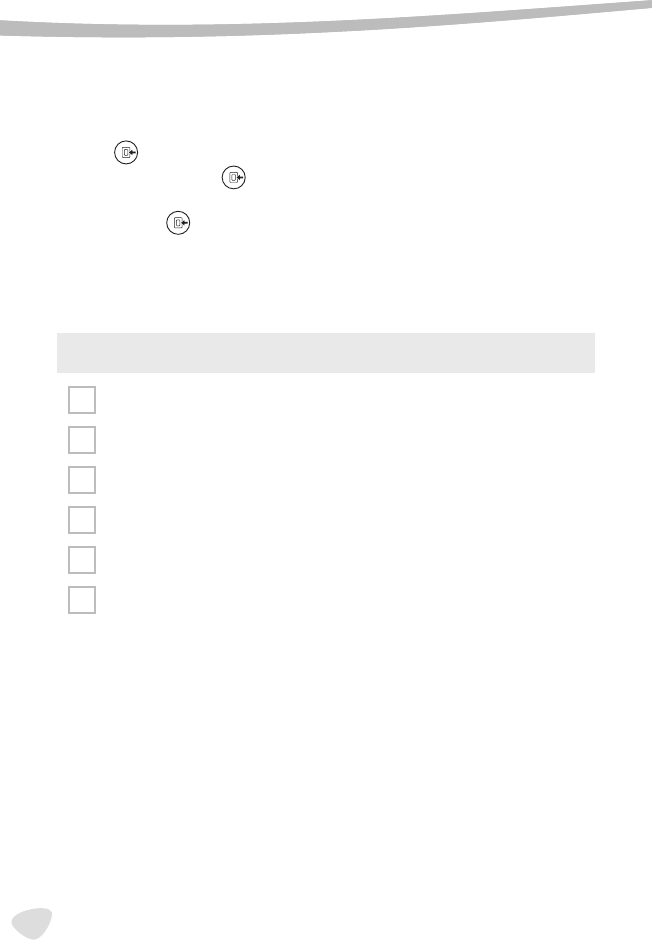
14
Changing the External Audio Source
• Press , to change the external sources.
• Each time you press your miniMedia switches to the next available
external source.
• If the button is pressed once only, miniMedia automatically
searches for available audio sources in the order indicated below. If an
available audio source is found, it is activated and the search process is
stopped. If no audio source is found, miniMedia switches back to the
hearing programs
Sequence of external source (if connected)
FM transmitter (using the FM input, DAI)
Direct audio input (2.5 mm stereo socket)
First transmitter
Second transmitter
Third party Bluetooth transmitter
Induction coil
i Your hearing system professional has to configure your miniMedia
for external devices.
i The direct audio input, the first and the second transmitter use the
same audio program, therefore the number of signal tones is the same
when switching between these audio sources.

15
• Signal tones sound when switching between external audio sources.
• While using an external audio source you can press , to turn the
microphones of your hearing systems off and on again.
• Press the program button P, to stop listening to the external audio
source and switch back to the hearing programs.
The hearing systems will switch automatically to the telephone program
when your phone rings.
• Press , to answer the phone.
• Press , to terminate the call.
Your hearing systems will change back to the prior used audio program
after terminating the call.
OR
• Press for about 3 seconds to reject the call.

16
Bluetooth is a wireless standard that provides a way to connect wireless
devices like cell phones, TV, headsets and others.
Using a Bluetooth connection, the devices can exchange information such
as data, sound or even control commands.
The range of the Bluetooth connection between the remote control and
the Bluetooth transmitter is approximately 10m. Walls or objects between
the devices can shorten this distance.
The miniMedia can be paired via Bluetooth with up to two phones, two
transmitters and a third party Bluetooth transmitter (e.g. MP3 player or
laptop) at the same time.
The following chapters give instructions about how to connect your phone,
TV or MP3 player with your hearing systems.
Bluetooth
i The Bluetooth symbol denotes if a device is Bluetooth compat-
ible.

17
When you are making a call with a Bluetooth compatible phone or cell
phone, the miniMedia allows you to use your hearing systems as a wire-
less headset.
Instead of using the telephone microphone, you speak into miniMedia
and listen through your hearing systems.
Pairing
Before you can use miniMedia with your phone, you need to pair them:
• Press for about 3 seconds to turn miniMedia on.
• Activate the Bluetooth function in your phone.
• Press for about 5 seconds to start pairing miniMedia with your
phone.
When pairing mode has been activated, all 3 buttons (On/Off button,
telephone button and audio source button) shine for 3 seconds, then the
telephone button flashes.
• Search in the menu of your phone for other Bluetooth devices.
• Choose „RCU Connect“ to pair miniMedia and the phone.
• Enter the PIN „0000“ if requested.
i Refer to the user guide of your connected device for more detailed
information on how to link devices via Bluetooth.
Using miniMedia with
Cell phones and Landline Phones
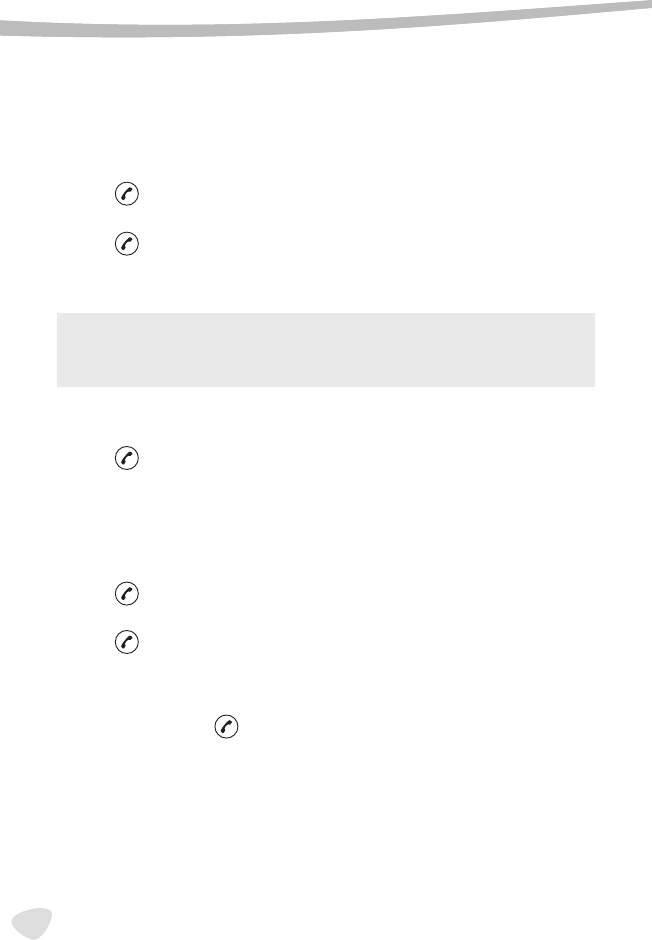
18
Accepting an Incoming Call
The hearing systems will switch automatically to the telephone program
when your phone rings.
• Press , to accept the incoming call.
• Speak into miniMedia‘s microphone to talk.
• Press again, to terminate the call.
Your hearing systems switch back to the hearing program or audio
source you were using before the call.
Rejecting an Incoming Call
• Press for about 3 seconds to reject the incoming call if supported by
the phone.
Making a Call
• Dial the required telephone number on your telephone and initiate the
dialing process.
• Press twice to transfer the connection from your phone to the
miniMedia. miniMedia can now be used for telephoning.
• Press twice to transfer the connection from the miniMedia back to
the phone. It is then not possible to telephone with miniMedia.
If your phone transfers the connection automatically you
do not need to press .
i If paired with two phones, miniMedia uses different ring tones to
distinguish incoming calls.
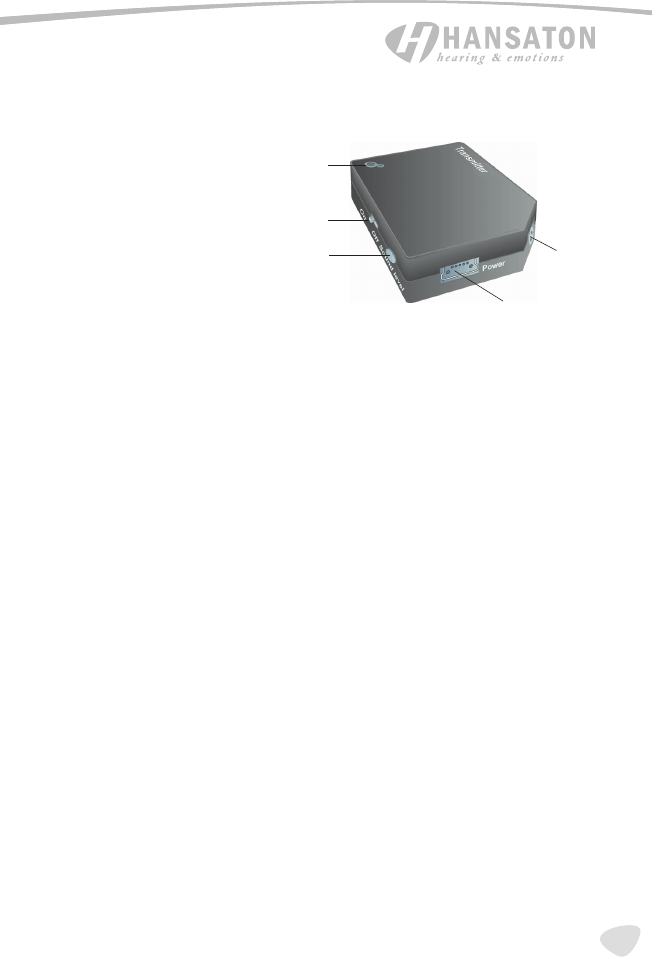
19
Using the Transmitter
1 On/Off switch
2 Sound level
3 Socket for power plug/
charging cable
4 2.5 mm stereo socket
5 LED
5
1
24
3
Before First Use
• Charge transmitter before first use.
Charging the Transmitter
• Connect the transmitter with the power plug to a power supply.
While charging the LED shines red.
Charging time is about 5 hours depending on the status of the recharge-
able battery.
The transmitter can also be connected permanently to a power supply
with a mains plug.
Turning the Transmitter On/Off
• Use the On/Off switch to turn the transmitter on. The LED flashes blue
while searching for a connection to the miniMedia, then the LED shines
blue.
• Use the On/Off switch to turn the transmitter off.
• Turn the transmitter off when it is not in use.
Sound Level
• Press the sound level button to change the volume of the audio signal.
The LED flashes blue. The number of times the LED flashes (up to 5),
indicates the volume level.
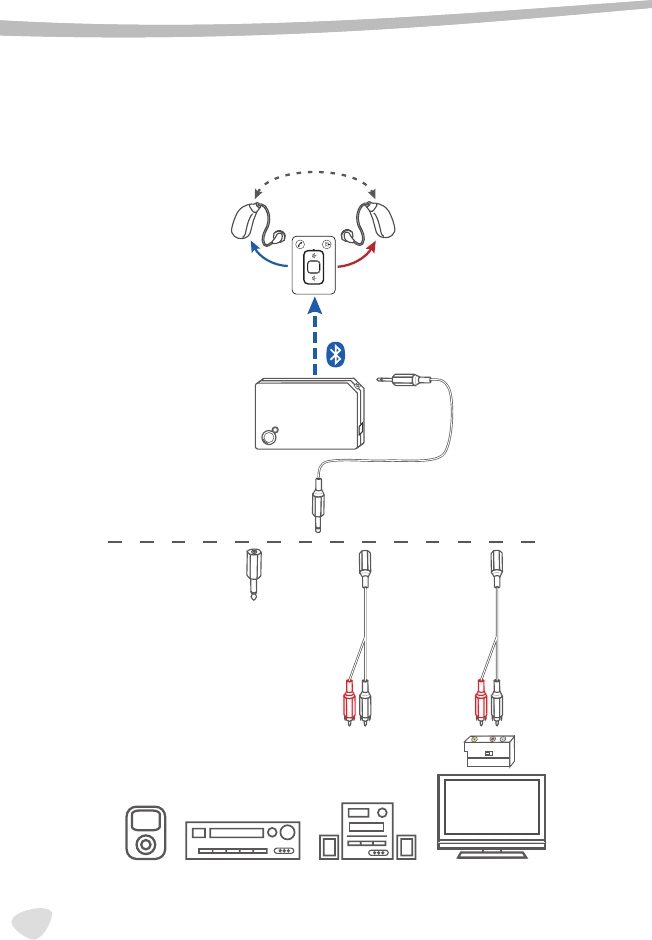
20
Receiving the Audio Stream from an External Device
Transmitter
TV
P
s

21
• Connect the transmitter with the power plug to a power supply or charge
the rechargeable battery regularly.
• Use one of the supplied cables to connect the transmitter to an external
device (refer to graphic on previous page).
• Press for about 3 seconds to turn the miniMedia on.
• Use the On/Off switch to turn the transmitter on.
• Press on miniMedia to change to the audio program (see chapter
“basic functions” for information about the sequence of external
sources).
flashes while searching a connection to the transmitter and shines
constantly after it is established.
The LED on the transmitter confirms that the Bluetooth audio link is
established (constantly blue).
• Start the audio transmission on your device. You can now hear the sound
from your external device through your hearing systems.
You can use a second transmitter, which is available as an accessory. This
way the first transmitter can always remain connected to your preferred
device while the second transmitter is connected with another device (e.g.
a second TV in your bedroom).
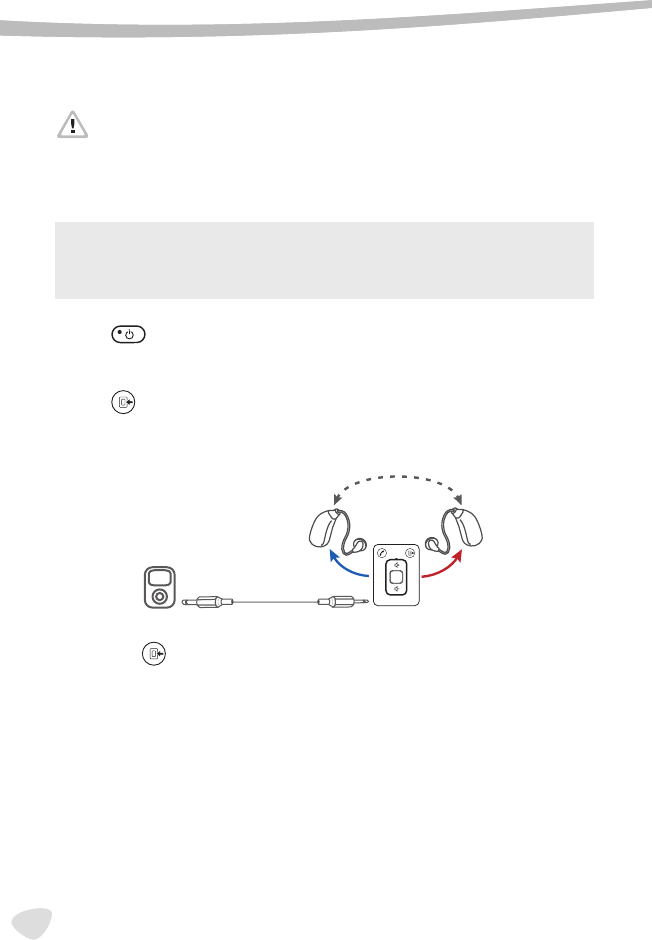
22
Using the Direct Audio Input
(2,5 mm stereo socket)
WARNING!
Risk of injuries caused by electric shock!
• Connect audio input only to a device conforming to IEC 60065
(IEC-Norm for audio, video and other electronic devices).
i • While charging do not use the direct audio input with devices that
are connected to the power supply.
• Press for about 3 seconds to turn miniMedia on.
• Use the supplied cables and adapters to connect the external device and
miniMedia.
• Press , to change to the audio program (see chapter “basic functions”
for information about the sequence of external sources).
P
s
If you press without an audio device connected to it, miniMedia will
search for a connection to other audio sources.

23
miniMedia can be connected via Bluetooth with a third party Bluetooth
transmitter (e.g. iPhone, iPod, BlackBerry, MP3 player, laptop).
Pairing
• Press for about 3 seconds to turn miniMedia on.
• Activate the Bluetooth function in your device.
• Press on your miniMedia for more than 5 seconds to prepare your
miniMedia for pairing.
When pairing mode has been activated, all 3 buttons (on/ off button,
telephone button and audio source button) shine for 3 seconds, then the
telephone button flashes.
• In the menu of your device choose „Bluetooth setup“.
• Choose „RCU Connect“ to pair miniMedia and the third party Bluetooth
transmitter.
• Enter the PIN „0000“ if requested.
Using
• Start the audio transmission on your device.
You can now hear sound from your device through your hearing systems
via Bluetooth.
• If the sound does not start automatically press to change to the audio
program (see chapter “Basic functions” for information about the
sequence of external sources).
i Refer to the user guide of your connected device for more detailed
information on how to link devices via Bluetooth.
Using miniMedia with
a Third Party Bluetooth Transmitter

24
FM System (Using the Direct Audio Input, DAI)
Your miniMedia can be connected to an FM system. This enables you to
use FM systems even with hearing systems which are not equipped with an
audio shoe. FM systems help to improve speech understanding in difficult
listening situations and are frequently used in schools.
• Press for about 3 seconds to turn the miniMedia on.
• Switch the FM system on.
• Connect the FM receiver with the DAI port of the miniMedia.
• Press on the miniMedia to switch to the FM system.
You can now hear sound from the FM system through your hearing
systems.
Hearing systems switch automatically to the telephone program when your
telephone rings and switch back to the FM system after you end the call.
Your miniMedia is equipped with an induction coil. This is intended for us-
ing induction loops, e. g. in churches, theaters or lecture rooms.
• Press for about 3 seconds to turn the miniMedia on.
• Press to change to the public loop receiver (see chapter „Basic
functions“).
You can now hear the sound from the public loop system through your
hearing systems.
The hearing systems will switch automatically to the telephone program
when your phone rings and will change back to the public loop system after
telephoning.
Using miniMedia with a Public Loop System
Accessories
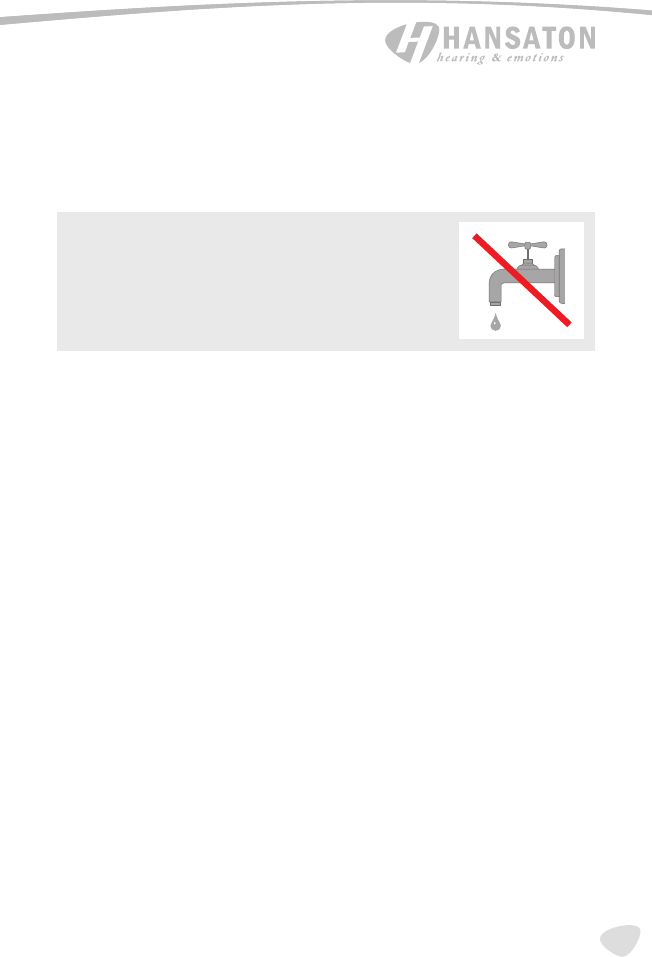
25
• Clean the remote control as necessary with a soft tissue.
• Avoid abrasive cleaning liquids with additives such as citric acids, ammo-
nia, etc.
Maintenance and Care
NOTICE
• Do not put your remote control in water!
• Do not clean your remote control with alcohol or
benzine.
HANSATON miniMedia
FCC ID: WU7-WL500
Operating frequencies: Fc = 3.28 MHz
Max. field strength @ 10 m: -24.1 dBμA/m
Max. field strength @ 30 m: -6.2 dBμV/m
CE and FCC compliance information can be found on the back of the
remote control.
Changes or modifications not expressly approved by the party responsible
for compliance could void the users authority to operate the equipment.
This device complies with Part 15 of the FCC Rules.
Operation is subject to the following conditions:
(1) this device may not cause harmful interference, and
(2) this device must accept any interference received, including interference
that may cause undesired operation.
This equipment has been tested and found to comply with the limits for a
Class B digital device, pursuant to Part 15 of the FCC Rules. These limits are
designed to provide reasonable protection against harmful interference in a
residential installation. This equipment generates, uses and can radiate
Technical Information

26
Disposal Information
i • Recycle the device and batteries according to national
regulations.
With the CE marking HANSATON confirms compliance with
the European Directive 93/42/EEC concerning medical devices
and the European Directive 99/5/EC (R&TTE) concerning radio
and telecommunications terminal equipment.
radio frequency energy and, if not installed and used in accordance with
the instructions, may cause harmful interference to radio communications.
However, there is no guarantee that interference will not occur in a particu-
lar installation. If this equipment does cause harmful interference to radio or
television reception, which can be determined by turning the equipment off
and on, the user is encouraged to try to correct the interference by one or
more of the following measures:
• Reorient or relocate the receiving antenna.
• Increase the separation between the equipment and receiver.
• Connect the equipment into an outlet on a circuit different from that to
which the receiver is connected.
• Consult the dealer or an experienced radio/TV technician for help.
HANSATON miniMedia Transmitter
This equipment should be installed and operated with minimum dis-
tance 20cm between the radiator & your body.

27
FDA Information (valid for USA only)
Use Your Hearing Systems All Day Long
The best way to ensure better hearing is to practice listening with your hear-
ing systems until you are able to wear them comfortably all day.
Generally, infrequent use of the hearing system does not provide you with
the full benefit of amplification.
Your hearing systems will not restore normal hearing. Hearing systems will
not prevent or improve hearing impairment resulting from a physiological
condition. Hearing systems will help you to make better use of your residual
hearing.
The use of hearing systems is only part of hearing rehabilitation; auditory
training and lip reading instruction may be required as weIl.
Possible Side Effects
The hearing system or earmold is a custom-made product. If you are expe-
riencing discomfort, see your audiologist or hearing system dispenser im-
mediately for modification of the hearing system or earmold at the point of
irritation. A hearing system or earmold may cause an accelerated accumula-
tion of cerumen (earwax). Also in rare cases, the otherwise non-allergenic
material may cause a discharge from the ear, allergic reaction, or any other
unusual condition. Please seek immediate consultation with a physician if
these conditions occur.
Warning to Hearing System Professionals
A hearing system dispenser should advise a prospective hearing system user
to consult promptly with a licensed physician (preferably an ear specialist)
before dispensing a hearing system if the hearing system dispenser deter-
mines through inquiry, actual observation, or review or any other available
information concerning the prospective user, that the prospective user has
any of the following conditions:
(i) Visible congenital or traumatic deformity of the ear.
(ii) History of active drainage from the ear within the previous 90 days.
(iii) History of sudden or rapidly progressive hearing loss within the previous
90 days.
(iv) Acute or chronic dizziness.
(v) Unilateral hearing loss of sudden or recent onset within the previous 90
days.
(vi) Audiometric air-bone gap equal to or greater than 15 decibels at 500
hertz (Hz), 1000 Hz and 2000 Hz.

28
(vii) Visible evidence of significant cerumen accumulation or a foreign body
in the ear canal.
(viii) Pain or discomfort in the ear.
Special care should be exercised in selecting and fitting a hearing system
whose maximum sound pressure level exceeds 132 decibels because there
may be risk of impairing the remaining hearing of the hearing system user.
Important Notice for Prospective Hearing System Users
Good health practice requires that a person with a hearing loss have a medi-
cal evaluation by a licensed physician (preferably a physician who specializes
in diseases of the ear) before purchasing a hearing system.
Licensed physicians who specialize in diseases of the ear are often referred
to as otolaryngologists, otologists, or otorhinolaryngologists. The purpose
of medical evaluation is to assure that all medically treatable conditions that
may affect hearing are identified and treated before the hearing system is
purchased.
Following the medical evaluation, the physician will give you a written state-
ment that states that your hearing loss has been medically evaluated and
that you may be considered a candidate for a hearing system. The physician
will refer you to an audiologist or a hearing system professional, as appropri-
ate, for a hearing system evaluation.
The audiologist or hearing system professional will conduct a hearing sys-
tem evaluation to assess your ability to hear with and without a hearing sys-
tem. The hearing system evaluation will enable the audiologist or dispenser
to select and fit a hearing system to your individual needs.
If you have reservations about your ability to adapt to amplification, you
should inquire about the availability of a trial-rental or purchase-option pro-
gram. Many hearing system professionals now offer programs that permit
you to wear a hearing system for a period of time for a nominal fee after
which you may decide if you want to purchase the hearing system.
Federal law restricts the sale of hearing system to those individuals who
have obtained a medical evaluation from a licensed physician. Federal
law permits a fully informed adult to sign a waiver statement declining the
medical evaluation for religious or personal beliefs that preclude consulta-
tion with a physician. The exercise of such a waiver is not in your best health
interest and its use is strongly discouraged.

29
Children with Hearing Loss
In addition to seeing a physician for a medical evaluation, a child with a
hearing loss should be directed to an audiologist for evaluation and reha-
bilitation since hearing loss may cause problems in language development
and the educational and social growth of a child. An audiologist is qualified
by training and experience to assist in the evaluation and rehabilitation of a
child with a hearing loss.
Identification Information
The year of manufacture is incorporated into the serial number. The warranty
is based upon the date of purchase, not date of manufacture. The serial
number may look similar to this sample: AJ12345. The second letter of this
serial number refers to the date of manufacture of the hearing system. The
letters progress in one-year increments, each reflecting the correspond-
ing year. The letter J means the year of manufacture is 2002, the letter K
indicates that the manufacture year is 2003, and so on. Your hearing system
professional can answer any questions you may have about the identifying
code on your hearing system.
OTHER WARNINGS!
• Do not use your hearing system in potentially explosive environ-
ments.
• If you experience dizziness, drainage or bleeding from the ear, or sud-
den hearing loss, see your Physician immediately.
• A hearing system may cause an accelerated accumulation of cerumen
(earwax).
• Keep hearing systems out of the reach of children, pets, and individuals
with diminished mental capacity.
• Hearing systems should be used only as directed and adjusted by your
trained hearing system professional .
• A hearing system may stop functioning, e.g. if the battery goes dead.
You should be aware of this possibility, in particular if you are in traffic or
otherwise depend on warning sounds.
• Do not switch hearing systems between ears or allow others to wear or
use your hearing systems.

30
• HEARING SYSTEMS WILL NOT RESTORE NORMAL HEARING AND
WILL NOT PREVENT OR IMPROVE A HEARING IMPAIRMENT RESULT-
ING FROM ORGANIC CONDITIONS.
• IN MOST CASES, INFREQUENT USE OF A HEARING SYSTEM DOES
NOT PERMIT USER TO ATTAIN FULL BENEFIT FROM IT.
• THE USE OF THE HEARING SYSTEM IS ONLY PART OF HEARING HA-
BILITATION AND MAY NEED TO BE SUPPLEMENTED BY AUDITORY
TRAINING AND INSTRUCTION IN LIP READING.

2011-07 SP
74200
Distributed by
Hansaton Acoustics Inc.
15650 36th Ave N Ste 110
Plymouth, MN 55446
USA
www.hansaton-usa.com
order@hansaton.com
Manufactured by
Hansaton Akustik GmbH
Stueckenstrasse 48
22081 Hamburg
Germany
Your hearing system professional ·
Su audioprotesista · Votre audioprothésiste: